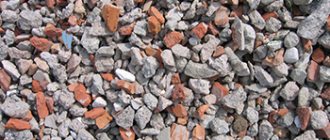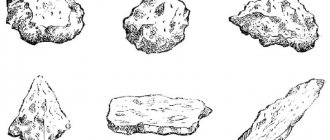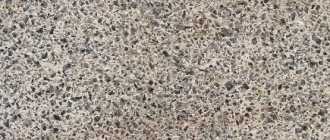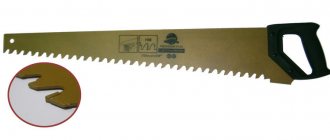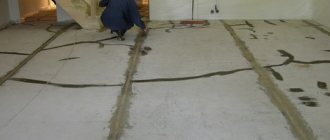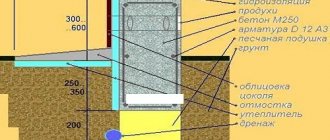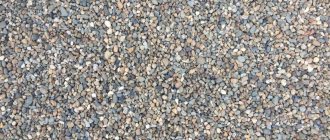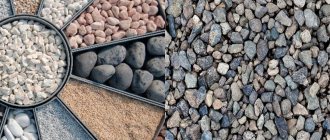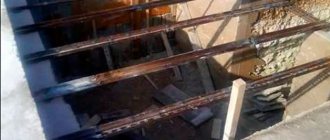In an effort to figure out what is the best crushed stone for drainage of a construction site, we very often go to extremes, giving preference to economically unprofitable backfill options. Meanwhile, choosing the “right” type of crushed stone allows you to save on arranging a drainage system.
Therefore, in this article we will determine the composition of the drainage bedding. We will offer our readers several options for fractions and several varieties of rocks suitable for the manufacture of the product that interests us. Moreover, when selecting the “right crushed stone”, we will take into account the “interests” of both drainage systems and building foundations.
Crushed stone for drainage
Why do we need crushed stone and gravel: compositions of drainage bedding
The introduction of crushed stone or gravel improves two characteristics of the supporting soil at once - drainage and load-bearing capacity. The first characteristic is responsible for the volume of moisture passed through the soil layers, and the second is the ability to resist external pressure without subsidence of the soil.
Drainage bedding
As a result, gravel or crushed stone bedding is used not only when arranging the drainage system, but also during the construction of the foundation. Moreover, in the first case, such bedding “works” as a filter barrier, partially purifying wastewater, preventing siltation of the drainage pipe and “conducting” atmospheric and groundwater to the wastewater main.
In the second case - during the construction of a foundation - the bedding “corrects” the insufficient bearing capacity of the supporting soil, simultaneously removing excess moisture from the base of the foundation. That is, thanks to the introduction of bedding into the pit, it is possible to change the bearing capacity and influence the magnitude of soil heaving deformations, which are directly related to soil moisture.
At the same time, the compositions of drainage and support bedding may be different. After all, “clean” crushed stone or gravel is not cheap.
Therefore, the bedding is formed from sand-gravel or sand-crushed stone mixtures, laying these materials in layers: 10-15 centimeters of crushed stone or gravel and 10-15 centimeters of sand.
What are the advantages of using gravel?
Concrete on gravel is cheaper than its related material on crushed stone. No crushers are used to produce gravel - it is simply taken from nature, in places where rocks and stones have been weathered for centuries and decomposed under the influence of ice and wind. Then all this is collected and sifted, leaving gravel - a large fraction more than 5 mm in diameter. Gravel, due to natural processing by the forces of nature, exhibits weak adhesive properties. It also has poor flakiness. To explain it more simply, flakiness is the angularity of stones and the presence of protrusions with roughness on which cement can catch. This is not a scientific description, but it is more understandable. Concrete on gravel does not have much strength because the fragments of this material do not adhere well to each other through hardening of the cement. Thus, gravel is used either as a cushion or where there are no significant loads on the surface, for example, for parking lots or walkways, floors in small architectural forms, etc. In general, concrete on gravel can also be used for decorative purposes for finishing walls, fences and building facades. Only the gravel in this case should be colored.
What kind of crushed stone is needed for drainage?
Granite crushed stone
Crushed stone is a product of rock processing. It is produced from large rock fragments using special crushers. Accordingly, this production method makes it possible to “produce” crushed stone from certain types of rock, with a strictly controlled “caliber” of the fraction.
Another advantage of crushed stone is its rough fault line. After all, this product was created artificially (in a crusher) And this quality increases the “filtering” ability of the drainage system. The chipped, rough surface of crushed stone literally attracts dirt particles.
Based on the type of rock used in the production of crushed stone, this product is divided into the following varieties:
Dolomite (lime) crushed stone
- Granite crushed stone is the most durable, frost-resistant and durable option that can be used for up to 50 years, in the most severe conditions (with any soil acidity). But granite has two disadvantages. Firstly, this breed has a natural radiation background (which scares off some buyers). Secondly, granite is very expensive. But the high price is justified by its phenomenal strength (a centimeter bedding can withstand about 100 tons of load) and enviable frost resistance (granite does not crack at any temperature).
- Dolomite (lime) crushed stone is the cheapest option, does not emit radiation and is absolutely inert from the point of view of environmentalists. But dolomite will “live” in difficult soil for no more than 15 years. Therefore, they try not to use crushed limestone for foundation drainage. After all, this material begins to crack at temperatures below -10 degrees Celsius. And the bearing capacity of a centimeter bedding is half that of granite crushed stone.
What gravel should I use for drainage?
Gravel is a product of nature itself. This is the name given to a mixture of small stones collected in quarries, river beds and on the shores of lakes or seas. A good example of gravel is river or sea pebbles.
Gravel for drainage system
Therefore, the main advantage of gravel is the low cost of the product. After all, nature itself created it. And the main drawback is the heterogeneity of the composition and “caliber” of the fraction. Typical gravel or crushed gravel, made from large pebbles and rock fragments, contains about one percent clay and sand and about two percent soft rock.
As a result, a centimeter bedding made of gravel or crushed gravel can withstand about 80 tons of load, and at temperatures below -20 degrees Celsius this material begins to collapse. Moreover, due to the smooth surface, gravel filters dirt very poorly and practically does not protect the pipe from silting.
Therefore, gravel and gravel crushed stone can be used in drainage systems only in combination with sand bedding, at least 10 centimeters thick. It will filter out dirt particles and protect the pipe from silt.
Characteristics of crushed stone
Small stone (from 10 mm), obtained by crushing rocks (the same gravel and boulders), is called crushed stone. The relatively clean condition and angularity makes it indispensable in the production of concrete building products and road surfacing. The constant use of crushed stone provoked a detailed study of the material and the identification of standards, categories, and characteristics. Thus, some of the important indicators are factionalism and flakiness. The grain size determines the scope of application; the most popular sizes are 20–60 mm. Flatness and elongation determine flakiness ('flakiness' is a flat board). The thinner and more needle-like the grain, the worse the strength and strength of the future product; a thin plate is fragile. In addition, dense compaction creates very massive structures that do not correspond to the maximum load withstand. A cuboid shape with volume and sharp corners is high-quality crushed stone.
Crushed stone is extracted in quarries. The initial formation corresponds to gravel. But then the crushed stone goes to processing plants. Where grinding, purification and fractionation are carried out. For construction needs, crushed stone is much better than gravel because it undergoes special processing.
Depending on the characteristics of the breed, density and quality differ. Granite is the most durable and accordingly expensive; and crushed stone obtained from gravel is cheap. The pricing of crushed stone is influenced by the amount of effort spent on processing. The ability to process crushed stone creates the prerequisites for its use as a secondary material. In this case, the global issue of disposal of construction waste is resolved.
Distinctive features between gravel and crushed stone:
- – The gravel is round and rounded. Crushed stone necessarily stands out with sharp corners.
- – Crushed stone is produced at a stone crushing plant from natural raw materials. And gravel is of absolutely natural origin. In the production process of crushed stone, washing is used, that is, the maximum possible removal of impurities and debris.
- – The size of crushed stone exceeds gravel. This is due to the imposed production requirements based on the application methods.
- – Gravel has little radioactivity. When buying crushed stone, radioactive radiation is one of the first questions of a savvy buyer. The degree indicator is recorded in certificates and sanitary-epidemiological reports.
- – Crushed stone is more monotonous in color palette. The gravel is colorful. The natural origin of gravel has a thousand-year history. During this time, a mixture of many breeds occurred. Crushed stone is often mined from rock that has been subjected to the same physical, geological, and climatic influences for a long time.
- – Crushed stone is a popular material in professional construction. Gravel is an ideal material for decorative and finishing works.
- – Gravel is a cheaper material than crushed stone. There are tasks when the price factor is the determining factor, then gravel is a more acceptable raw material. If the cost of crushed stone, on average, of a low-demand type starts from 700 rubles, then the most expensive gravel is up to 700 rubles.
How is the crushed stone fraction for drainage selected?
Typically, five fractions of crushed stone “come out” of the crusher:
Crushed stone fractions of different sizes for drainage
- The first is with debris dimensions up to 5 millimeters. It is not suitable for drainage systems, since it contains all the screenings, which will simply be washed away by groundwater.
- The second is with fraction dimensions from 5 to 20 millimeters. It is not suitable for a drainage system for a completely different reason - such crushed stone is in great demand in construction and the production of reinforced concrete products, so this product is not cheap.
- The third - with a “caliber” fraction of 20-40 millimeters. This is perhaps the best type of crushed stone, from the point of view of drainage specialists. It is relatively cheap and does not contain screenings or dust.
- The fourth - with fragment sizes from 40 to 90 millimeters. This is also a good option, but due to the significant dimensions of the debris (up to 9 centimeters), it is practically unsuitable for “manual” construction. Such crushed stone is poured into a drainage trench or into a foundation pit using an excavator.
- The fifth - with dimensions from 100 to 300 millimeters. This is a decorative type of crushed stone. It is not used either in the production of reinforced concrete or in soil drainage. Such crushed stone is of interest only to interior, exterior and landscape designers.
How does the crushed stone fraction affect the quality of concrete?
Concrete is a building material consisting of certain proportions of sand, cement, crushed stone and water.
Each of the component parts does its job, and only when their interaction is harmonious can high-quality and durable concrete be obtained. Cement acts as the main binding component; it can be replaced with other materials that have viscosity - lime or gypsum. Water, diluting the cement, brings it into a plastic state, and then, through chemical reactions inside the mixture, the cement hardens. Water must be used clean, without obvious contaminants and impurities; the temperature of the water is also important - in hot weather it must be cooled, and in cold weather it must be heated. Sand and crushed stone act as fillers of various sizes; their specific gravity usually reaches 80% of the total volume, while significant savings can be made on the more expensive material - cement. The function of the aggregate is to give rigidity to the concrete, as well as the ability to adjust the density of the solution. The finer the filler, the fewer voids in the concrete, which means it is stronger. Heavy filler gives concrete the additional quality of being impenetrable to radiation. And a light filler, such as expanded clay, allows you to make the structure very light. Sand for concrete needs to be river sand, dry and clean. The production of crushed stone takes place in quarries; for this purpose, rocks are crushed into stones of different sizes, and uneven chips of crushed stone contribute to excellent adhesion of all components of the concrete mixture
A natural filler of natural origin - crushed stone - gives high strength to the object and significantly increases the service life of structures. Crushed stone is distinguished by the shape and size of the grains, and the size is determined by the maximum permissible size of one grain of crushed stone, as well as by the type of rock from which the stone is made. The main fractions of crushed stone range in size from 5-10mm to 40-70mm, and the accompanying fractions are very small, ranging in size from 0 to 5 mm. Sometimes there are construction projects that require crushed stone measuring 150 mm, but these are isolated cases. For traditional concrete mortars, fine-grained crushed stone is used, the grain size of which is 2-20 mm; it is suitable for optimally filling the mass and bringing the number of voids and porosities to zero. But still, if there is a need to use larger crushed stone, then, according to building codes, the size of the stone cannot exceed one third of the size of the smallest part in the structure, and in no case can it be more than 150 mm.
nerudr.ru

